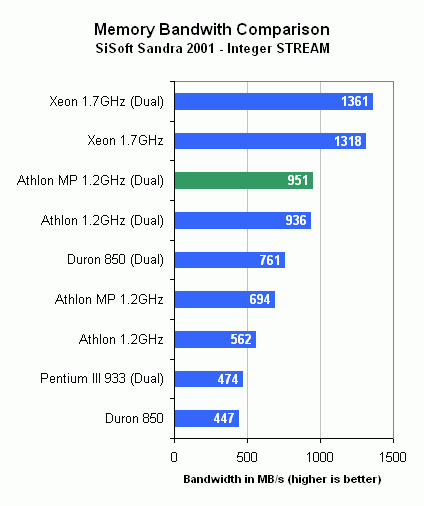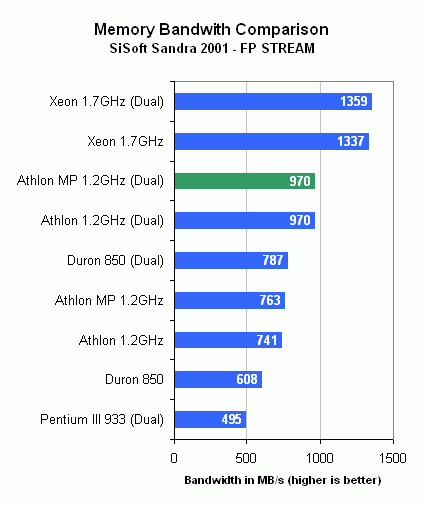AMD 760MP & Athlon MP - Dual Processor Heaven
by Anand Lal Shimpi on June 5, 2001 12:00 PM EST- Posted in
- CPUs
Memory Bandwidth Comparison
Although we're not big fans of SiSoft Sandra as a benchmark, the memory bandwidth test contained within the suite has proved to be quite useful. Without a doubt the Xeon offers the greatest amount of useable memory bandwidth of the collection; the i860's dual channel RDRAM interface provides for a theoretical maximum of 3.2GB/s of bandwidth to main memory. According to these results, approximately 44% of the bandwidth is actually being used by the two Xeon processors. Even with only a single Xeon processor present in the system, the bandwidth usage figures do not change. This indicates that either the FSB or memory bus is saturated already by a single Xeon at 1.7GHz.
Things get even more interesting when you look at the Athlon MP Single vs. Dual bandwidth figures. By going to a DP configuration, the Athlon MP's memory bandwidth figures increase a whopping 37%. A single processor Athlon MP manages to use approximately 33% of its 2.1GB/s of memory bandwidth, but going to two processors takes the memory bandwidth utilization up to 45%; even higher than that of the Xeons on the i860. Similar increases in memory bandwidth utilization are present when looking at the regular Athlon and Duron scores.
Let's take a look at the FP STREAM results before we begin dissecting exactly what's going on here.
Similar results are present in the FP STREAM tests under Sandra 2001. For starters, the Xeon platform offers and takes advantage of the most amount of memory bandwidth of the group. The performance difference between the single and dual Xeon configurations is next to nothing, both offering around 1400MB/s of bandwidth.
Again the really interesting numbers come from the Single vs. Dual comparisons on the 760MP. Here the Athlon MP goes from using 36% of its memory bandwidth to using 46%. The question is why?
Remember that the 760MP is the only dual platform here to have a Point-to-Point FSB. A single Athlon MP CPU in this case can eat up approximately 700 - 800MB/s of memory bandwidth, adding a second CPU means that the total system (since each CPU gets a full 2.1GB/s path to the North Bridge) could consume at most twice that much memory bandwidth. Obviously since performance doesn't scale perfectly when going to multiple processors we don't see this sort of scaling, but the fact that we see any increase in memory bandwidth utilization indicates that in a single processor Athlon system the FSB is limiting the processor's utilization of its memory bandwidth.
If this is true then it could also mean that one of the reasons that the Pentium 4 (and Xeon) do so well in these tests is because of the 100MHz quad-pumped FSB.












0 Comments
View All Comments